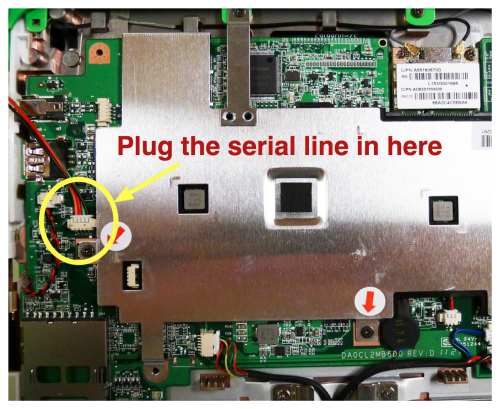XO 1.75 11089 Fix: Difference between revisions
(Added missing link to firmware) |
|||
| Line 19: | Line 19: | ||
* [[Disassembly_top|Disassemble the target laptop]] to access the motherboard. The display does not need to be disconnected; it can be moved slightly out of the way to access the back panel screws (after removing the back panel screws it helps to screw one or two display screws so that the display is not in the way while attaching the serial cable). The heat spreader does not have to be removed. |
* [[Disassembly_top|Disassemble the target laptop]] to access the motherboard. The display does not need to be disconnected; it can be moved slightly out of the way to access the back panel screws (after removing the back panel screws it helps to screw one or two display screws so that the display is not in the way while attaching the serial cable). The heat spreader does not have to be removed. |
||
* Plug the white end of the serial cable into the target, see [[#Finding_the_Serial_Port|below]] for where it goes, |
* Plug the white end of the serial cable into the target, see [[#Finding_the_Serial_Port|below]] for where it goes, |
||
* Plug in a USB drive with q4b06.rom into the target, |
* Plug in a USB drive with [http://dev.laptop.org/pub/firmware/q4b06/q4b06.rom q4b06.rom] into the target, |
||
* Attach the black end of the serial cable to a [[Serial_adapters|serial adapter]], |
* Attach the black end of the serial cable to a [[Serial_adapters|serial adapter]], |
||
* Attach the serial adapter to the host, |
* Attach the serial adapter to the host, |
||
Revision as of 17:07, 11 October 2011
Version Q4B05 of OpenFirmware for the XO 1.75 B1 laptop had a bug (<trac>11089</trac>) which caused the laptops to boot up with a white screen if it has been ten days since their manufacture, or if the RTC battery is removed. The symptom is a blank white screen on power-up.
The bug is fixed in Q4B06 of OpenFirmware. These instructions have only been formally tested with Q4B06. Later versions might work, but have not been formally tested.
You Need
- the bricked laptop, we call it the target,
- another computer, we call it the host,
- a serial adapter,
- the coloured serial cable compatible with the adapter,
- a screwdriver,
- a USB drive,
- between five and fifty minutes depending on your skill.
Preparation
- Turn off the target, unplug the power cable, and remove the battery,
- Disassemble the target laptop to access the motherboard. The display does not need to be disconnected; it can be moved slightly out of the way to access the back panel screws (after removing the back panel screws it helps to screw one or two display screws so that the display is not in the way while attaching the serial cable). The heat spreader does not have to be removed.
- Plug the white end of the serial cable into the target, see below for where it goes,
- Plug in a USB drive with q4b06.rom into the target,
- Attach the black end of the serial cable to a serial adapter,
- Attach the serial adapter to the host,
- Insert the battery into the target,
- Plug the power cable back in to the target, (use only the provided power adapter, not an older one),
- Configure a terminal emulator on the host,
Power On
Power on the target, while watching the terminal emulator.
The target will transmit a log of the boot sequence via the serial port, which will be shown by the terminal emulator on the host. The sequence should end in Unsupported SPI FLASH ID and an ok prompt. If at this point, it stops somewhere else or doesn't provide a prompt (like after Releasing) you have another problem; please contact wad.
Fix
Initialise the USB stack, by typing in the terminal emulator:
ok dir u:
Then, rewrite the firmware and reboot, by typing in the terminal emulator
ok flash u:\q4b06.rom
The target should reboot into Linux, showing you have completed the fix.
You may now shutdown, turn off the target, remove the serial cable (if it is no longer required), and reassemble.
Finding the Serial Port
You will need an XO serial adapter designed for use with XOs. The serial port to use is UART3 (CN8). There is a chart showing the location, and this photo:
